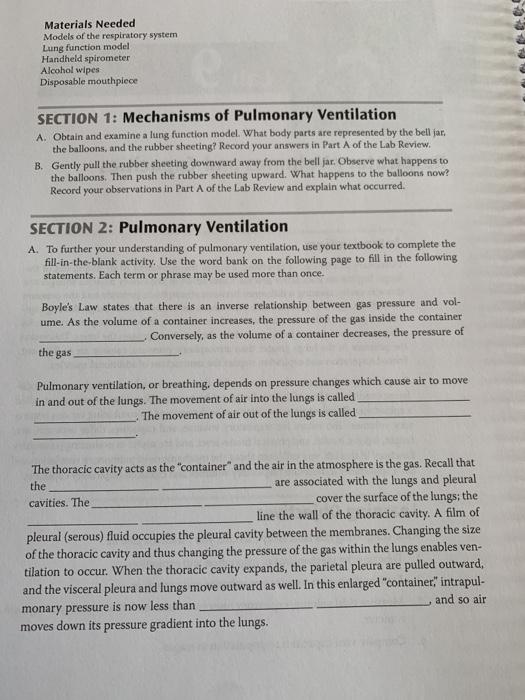
Materials Needed Models of the respiratory system Lung function model Handheld spirometer Alcohol wipes Disposable mouthpiece SECTION 1: Mechanisms of Pulmonary Ventilation A. Obtain and examine a lung function model. What body parts are represented by the bell jar, the balloons, and the rubber sheeting? Record your answers in Part A of the Lab Review, B. Gently pull the rubber sheeting downward away from the bell jar. Observe what happens to the balloons. Then push the rubber sheeting upward. What happens to the balloons now? Record your observations in Part of the Lab Review and explain what occurred. SECTION 2: Pulmonary Ventilation A. To further your understanding of pulmonary ventilation, use your textbook to complete the fill-in-the-blank activity. Use the word bank on the following page to fill in the following statements. Each term or phrase may be used more than once. Boyle's Law states that there is an inverse relationship between gas pressure and vol- ume. As the volume of a container increases, the pressure of the gas inside the container Conversely, as the volume of a container decreases, the pressure of the gas Pulmonary ventilation, or breathing, depends on pressure changes which cause air to move in and out of the lungs. The movement of air into the lungs is called The movement of air out of the lungs is called The thoracic cavity acts as the "container" and the air in the atmosphere is the gas. Recall that the are associated with the lungs and pleural cavities. The cover the surface of the lungs; the line the wall of the thoracic cavity. A film of pleural (serous) fluid occupies the pleural cavity between the membranes. Changing the size of the thoracic cavity and thus changing the pressure of the gas within the lungs enables ven- tilation to occur. When the thoracic cavity expands, the parietal pleura are pulled outward, and the visceral pleura and lungs move outward as well. In this enlarged "container" intrapul- and so air monary pressure is now less than moves down its pressure gradient into the lungs.
Respiratory Volumes and capacities 1 101 But how do we change the size of the thoracic cavity? This requires the action of differ ent skeletal muscles. Resting inhalation requires the contraction of the dome-shaped and the musdes During inhalation, the Plattens and the muscles lift the ribs upward and outward. Increasing the size of the thoracic cavity. Intrapulmonary pressure decreases below atmospheric pressure and air rashes into the lungs. In forceful inhalation, these muscles are assisted by the and During exhalation, respiratory muscles relax: the rebounds and the muscles relax, allowing the ribs to lower The size of the thoracic cavity and pres sure above atmospheric pressure so that air is pushed out of the lungs. Resting exhalation is a passive process: forceful exhalation requires the action of the muscles, which pushes the diaphragm more forcefully upward. This makes the thoracic cavity even smalles, increasing pressure even more, and thus pushing more air out of the lungs. and WORD BANK atmospheric pressure internal intercostal exhalation (expiration) decreases external intercostal increases scalenes pectoralis minor abdominal sternocleidomastoid inhalation inspiration) intrapulmonary parietal pleura serratus anterior visceral pleura diaphragm pleural membranes
没有找到相关结果